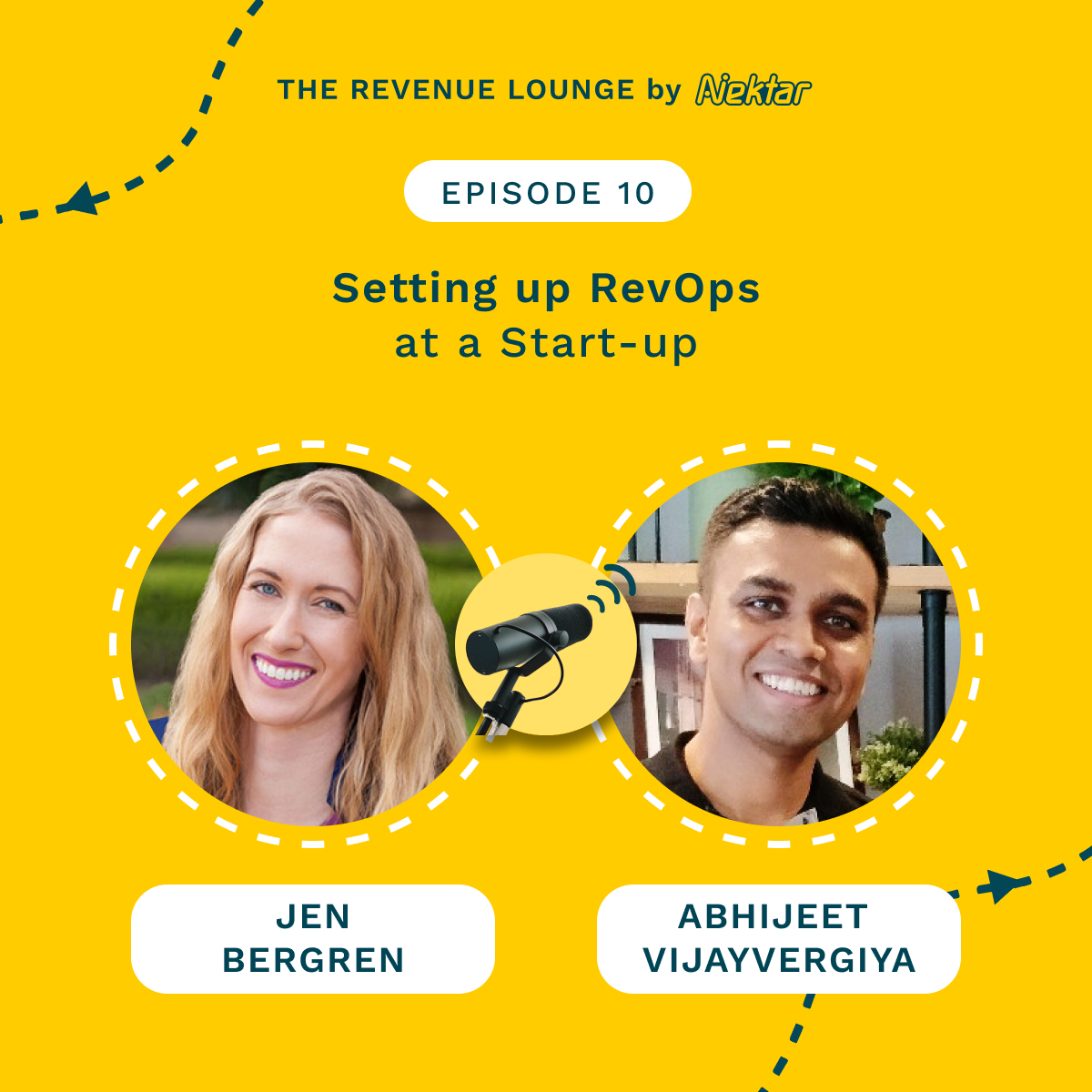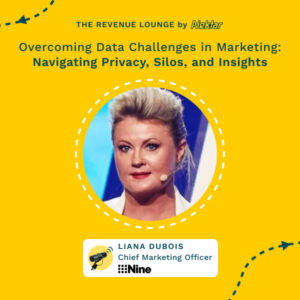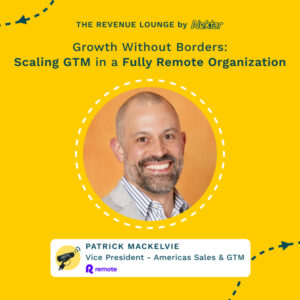Data Driven Decision Making: Mastering the Art of Strategic Action ft. Sarah Flaccavento
October 23, 2024
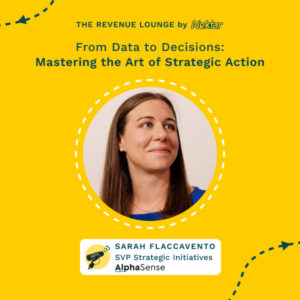
About
The Revenue Lounge
The podcast covers stories from leaders across RevOps, Sales, Customer Success, GTM, Data and Marketing about what drives these functions and what advice they would share with our listeners. With 3 seasons recorded, the podcast currently features 50+ enterprise leaders in the B2B SaaS domain. Tune in to hear from the best in the business
In this episode of the Revenue Lounge, host Randy Likas interviews Sarah Flaccavento, SVP of Strategic Initiatives at AlphaSense, about using data to drive business decisions and growth. They discuss strategies for identifying impactful initiatives, translating data into actionable insights, managing organizational change, and more.
Key Discussion Points:
– How to prioritize strategic initiatives using weighted criteria like ROI, difficulty, time-criticality (07:07)
– Shifting focus from increasing ARPU to capturing full customer value over time (33:14)
– Turning data into insights that answer key business questions and enable recommendations (38:38)
– Getting stakeholder buy-in by “democratizing” data access and transparency (40:00)
– Failing fast with small experiments vs. parking ideas for later with clear metrics (46:17)
Guest Bio:
Sarah Flaccavento is SVP of Strategic Initiatives at AlphaSense, a B2B search company providing access and insights across public and private content. She has over 13 years of experience in sales, revenue operations, product management, and integration strategy.
Company Bio:
AlphaSense provides search-driven insights to financial, strategy, and market intelligence professionals. Their AI technology extracts key insights from public and private content to inform better business decisions.
Quotes & Timestamps:
“Data is the new oil, powering decisions and driving strategic growth.” (00:00:28)
“The challenge lies not in just collecting the data, but in transforming it into actionable insights that can propel an organization forward.” (00:00:32)
“If you can’t put your finger on the fact that you are measuring both of those things on everything you’re working on, you are not setting yourself up for long term success.” (00:35:00)
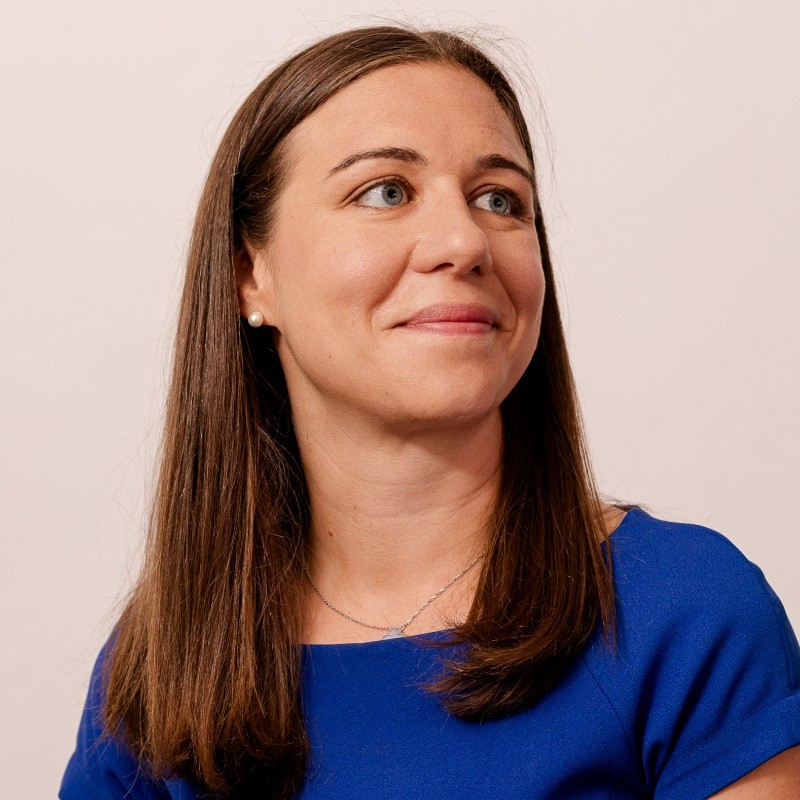
Randy Likas (00:02.504)
Data is the new oil powering decisions and driving strategic growth. However, the challenge lies not in just collecting the data, but in transforming it into actionable insights that can propel an organization forward. Many companies struggle with the critical step of bridging the gap between data and translating it into the insights that drive meaningful action. Hello everyone, welcome to the Revenue Lounge podcast. I am your host, Randy Likas. And in today’s episode, will delve into the art of moving from data to decisions.
exploring how organizations can master the strategic use of data to drive tangible business outcomes. We’ll uncover the common hurdles that businesses face and discuss actionable strategies to overcome them, ensuring that data -driven decision -making isn’t just a buzzword, but a core operational practice. And joining me today is Sarah Flaccavento. Sarah is the Senior Vice President of Strategic Initiatives at AlphaSense. She is a strategic leader skilled at stabilizing and rectifying challenges within complex organizations as well as serving
as an innovator and force multiplier driving go -to -market initiatives. Sarah, welcome to the Revenue Lounge. Thank you so much for joining us today.
Sarah Flaccavento (01:05.235)
Randy, thank you so much for having me. I’m so excited to be here.
Randy Likas (01:07.452)
Yeah, I’m excited as well. So Sarah, we usually like to start with maybe just understanding who you are. so maybe you can spend a couple of minutes sharing sort of your journey with AlphaSense so far, maybe a little bit about your role and maybe sort of the key strategic priorities that kind of land on your agenda.
Sarah Flaccavento (01:27.626)
Absolutely. So I’ve been at AlphaSense for about two years. I run a team that actually we created in the last two years called Strategic Initiatives. And really what that means is we are responsible for making sure that there is an ever present focus on force multiplying change at the company. And so that can mean different things in every quarter and I’m…
Guessing many people know that that means it does mean different things in every quarter, but that’s things like geographic expansion. We went into APAC in a big way this year. It means segment optimization, persona expansion. We’re selling to people who’ve never even seen our products before and didn’t know they needed us until we told them why, right? We are working on partnerships in a big way. We are making updates and being really thoughtful about how pricing and packaging changes as the way people use technology changes.
I put a lot of time into the integration of acquisitions. We made some really big plays this year that I dare may not end up mentioning in all of the things that are top of mind for me right now. So those are the types of things that my team focuses on. But maybe how did I get to this point? I was at S &P for 13 years before I joined AlphaSense. I started my career at S &P as a seller. And I will say one of my favorite facts is that
Randy Likas (02:24.014)
Yes, she did.
Sarah Flaccavento (02:47.118)
almost 93 % last I read a stat of CEOs were sellers at some point. So, fell. Everything is sales, life is sales. And I think that that really set me up to be in a world where I understand how to pick what is the most important of all of your opportunities, right? So I started my career, I sold to hedge funds in New York for five years. At some point they asked me to take on what was the building of a sales team and then a sales development program.
Randy Likas (02:56.536)
Yep.
Sarah Flaccavento (03:16.078)
I think I learned in that process that I liked building the thing, maybe even a little bit more than I liked running the thing. And so I built an org. I sort of thought really carefully about how you set sellers up to be successful and long careers of hitting numbers and knowing how to ask for what they need and knowing how to be nimble and thoughtful and speak to customers the way they wanted to hear. And then I realized there was a way to translate that to doing product work. And so I took on what was a major product migration at S &P at the time.
And that ended with what was learning to sell internally, what is the voice of your customer, which led me to take on a rev ops org and then the integration of acquisitions into revenue. And then what was a strategic initiatives function at S and P and all of those things sort of built on themselves to be what was a holistic view of how you prioritize the most important, most critical, most
in my case, interesting problems to solve at a company and how you make sure you are always focused not just on this year’s revenue, but what sets you up for next year’s revenue and revenue the year after, which is those force -multiplying changes and picking the right ones and focusing on them. And I really like, I think you said, we’re calling today’s episode, data is the new oil. Great quote, love that quote. Data is the new oil. That’s the secret sauce to how you win.
Randy Likas (04:38.339)
Yeah.
Randy Likas (04:43.845)
Absolutely. Yeah, and it’s funny because I think a lot of people, you you say data -driven decision making, you go, yeah, I’m data -driven decision making, right? And people have access to a lot of different data, but I think what’s critical is how do you use that data to sort of look for the connective tissue, right, and connect it with the problems that you’re trying to solve. So before we get into that, you talked something, you mentioned something about like the ability to…
Sarah Flaccavento (04:44.652)
What are the most important things to think about?
Randy Likas (05:10.171)
picks the most important projects, the most important initiatives that you solve. We’d love to dive into that a little bit more. So like, how does that thought process work and what do you look for in terms of where you invest your time and resources?
Sarah Flaccavento (05:21.442)
I love that question. I think I mentioned briefly that I had the luxury of owning what was a product org for a couple of years in my time at S &P. And I think one of the most important things I took out of that, there’s a methodology in products today called SAFE. It’s the Scaled Agile Framework. There’s a whole lot of jargon and a whole lot of ways that it teaches you to run building products the most effectively.
The thing I took out of it the most, I was very lucky to have a product leader who understood the details of actually how you set up a Scrum team and how you write lines of code. I had the opportunity to learn how you do what they call lean portfolio management. And one of my favorite teachings of Agile, of SAFE, was the weighted shortest job first methodology. Lovingly referred to as Wisjif.
Randy Likas (06:10.618)
Hmm?
Sarah Flaccavento (06:16.038)
What it does is it takes ROI, which is a concept I think we all sort of innately understand, right? Executives walk into a room and they, in their core, know they’re trying to do the thing that will bring the highest return on their investment, right? I think we kind of get that. We have a dollar bill. We know what to do with it. I think it’s missing the third component that WizJif puts into the equation, which I actually think ends up…
Randy Likas (06:29.734)
Mm -hmm.
Sarah Flaccavento (06:41.474)
particularly in the world of software, in the world of ever -present change, particularly in the world of generative AI search that AlphaSense is playing in right now, which is sort of at the center of a whole lot of people’s thoughts, the most important piece, and that’s time criticality. So think about this with me, right? AlphaSense does sell to and could make a big bet to sell to law firms more than we do today. That would be a…
many, many, many, many billions of dollars, if not trillions of dollars of TAM we would open up by doing that. It would be very hard to do. But if you do the math on the ROI, it would probably tell you we should do it, because they would have the biggest impact, one of the biggest impacts for our TAM, that or something else of that size. And the investment is worth it to get the data, to change the product, to be ready to go after the market. What that doesn’t take into account is time criticality.
Randy Likas (07:14.77)
Yeah.
Randy Likas (07:30.705)
Thank
Sarah Flaccavento (07:39.254)
And so if I don’t do that today, is there someone else poised to do it today? Is there someone else who’s gonna take that opportunity off my plate tomorrow because I didn’t do it today? And the answer is probably not. There’s no one who’s about to do it. But you know what is really time critical in this moment? Learning, teaching generative AI search to marry the external content that a whole lot of data providers provide.
and all that internal content that your organization has created or any organization has created. And no one is solving that problem. But I can tell you, my customers today need the answer to that problem. And if I don’t get there tomorrow, someone else will. And sneak peek, Alpecense did. We built an enterprise intelligence product, really cool and interesting. But it is that time criticality.
that led us to focus on that is that time criticality that told us it is this moment. And sometimes time criticality knocks things down the list. And sometimes time criticality helps you actually play with ROI, right? Like it helps you decide, is this the moment to choose a partner? Maybe they wouldn’t be as good at it as us. Maybe the return would be lower, but the amount of resource I have to put towards this is not high enough. And it’s not time critical.
Randy Likas (08:40.691)
Mm -hmm.
Randy Likas (08:56.115)
.
Sarah Flaccavento (09:00.234)
unless you think about the fact someone else might partner with them first. So, weighted shortest job first with that component of time criticality, weighing what is the size of the prize, what is the difficulty, and time criticality. And then there’s a whole lot of math to it. uses a Fibonacci sequence. Highly recommend for anyone trying to do really big prioritization. I did it in my renovation of my apartment, because I can’t help myself. So, let me know if you want my spreadsheet.
Randy Likas (09:03.869)
Mm -hmm.
Randy Likas (09:19.303)
Yeah.
Randy Likas (09:25.967)
Thank
Yeah, maybe I will take you up on that. It’s fascinating. So everyone is in planning season for next year, but it sounds like these things that we’re talking with Wisjif, it’s not next year, it’s multiple years. So I’m curious, what are the planning cycles for something like this Wisjif? How often do you refresh it?
Sarah Flaccavento (09:51.726)
So I think there’s a couple of secrets there. One, you want to set priorities at least a quarter out. Really, you should have three levels of priorities in your business at any given time. You should be fixed for a quarter out. You should be sort of partially fixed for six months out. And then there’s like the one, three, five year version, depending on who you are, what type of business you’re in. I’m playing in the generative AI space. No one’s really 100 % fixed five years out because.
We’ll be on GPT 70 by then. And we’ll all be trying to make sure we’re solving different problems than they’re solving. It is that sort long -term time horizon, which is different for every business. And knowing what requirements sit in each of those spaces is the first piece. So figuring out what time horizon you’re planning for, and you should be planning for all three at any given time. There’s sort of a theory that you should have your objectives.
Randy Likas (10:21.617)
Right.
Randy Likas (10:26.216)
Yeah.
Randy Likas (10:36.776)
Mm -hmm.
Sarah Flaccavento (10:46.892)
right, really far out, and then your key results that you’re measuring towards on a shorter time horizon. I think that OKR process, there’s a thousand theories out there for how you do it. Really, the idea is know what your big bets are and have pretty high conviction in what those big bets are, and then less conviction, ability to be fungible with how you execute on what those big bets are, right? It’s not this feature. It’s not this rev -op system. It’s not…
this specific client, it’s this client type. It’s a system that solves this problem. It’s a set of features that answers this workflow that is creating problems rather than marrying yourself to any individual thing in the short term. And that’s how that data comes into play, right? So you set pretty good criteria a quarter out where you’ve picked which feature, which thing you’re implementing. Six months out, know which problems pretty clearly you’re trying to solve. Far out, you know what your objectives are.
Randy Likas (11:19.879)
Mm -hmm.
Sarah Flaccavento (11:46.368)
And then you refresh at least on a quarterly basis. I refresh on a monthly basis and I share out with the rest of our executive team on a quarterly basis. And the secret is, so my number two, I keep it all in a spreadsheet. One, I make my team independently input their Fibonacci sequence numbers for difficulty, size of the prize, and urgency. See if we get to the same numbers, because sometimes you don’t, and it’s a really fun team meeting when you don’t. And then also,
Randy Likas (11:46.738)
Mm
Randy Likas (11:50.407)
Okay.
Sarah Flaccavento (12:15.668)
Rather than changing your column, and I know this is so ridiculous, I keep it in an Excel spreadsheet because my soul is still in an Excel spreadsheet. You just start to hide, you hide the columns for every previous quarter. And before you publish your updated ranking, you unhide and you make sure that if there’s anything that has a major Delta and priority, you know why. And you’ve answered your question. And actually that’s one of the first pieces of data.
I never want something to move significantly from a top five priority to not a top five priority from above the fold, right? Like people like to use that term about the newspaper. it’s above the fold, it’s the things you’re working on below the fold, the things you’re not working on, right? And yeah, a good newspaper reference is always important these days. But when it falls below the fold, right, these major changes, things that are gonna be fully resourced versus partially resourced versus not resourced or maybe resourced, that’s when you go back and you say,
Did this happen because it was someone’s gut and we all just had a gut change? Or is this validated by data? Did we measure to the outcomes we expected and either we underperformed in things that moved down the list, we overperformed in things that moved up the list, we introduced new things that we still, when we see how that comes out, have conviction are more important than the things we had originally prioritized? Or was this like we had a
Randy Likas (13:21.682)
Thank
Randy Likas (13:35.696)
Mm
Sarah Flaccavento (13:41.314)
bad couple of weeks and you know, one round of customer feedback came back in a way that felt negative or we had a product delay or we negotiated with the vendor on something we were trying to buy and they told us it going to cost more than we expected and so we’re kind of cranky about it and it’s a feeling, right? And I think that that’s, it’s that moment of keeping the priority and forcing yourself to look back at what you thought was really important three months ago or six months ago that reminds you.
Randy Likas (13:57.051)
Bye.
Sarah Flaccavento (14:09.356)
that it is not, it can never just be a feeling. It has to be what is based on something data -driven. And that then goes back to what were you tracking and what did you choose to track?
Randy Likas (14:18.257)
Mm -hmm.
Yeah, so the answer I’m sure probably depends on what we’re looking at. But curious when you’re looking at those items that are above the fold, like what are the sources of data that you pull from to help inform those decisions?
Sarah Flaccavento (14:35.532)
Yeah, I think there’s a whole lot of inputs that depend into, right? I you just said that? Into what is the size of the prize. So I’m a big believer in like know your TAM and like really know your TAM and then almost never touch it again. Your TAM is aspirational. Leave it over there. Do some good math. Have RevOps refresh it once a year, right? Like pay someone to refresh it once a year for you based on all the sources on the internet. And now your job is to convert TAM to S.
It’s like, how do you take that really big number, which theoretically, if you have product market fit and you are at the right place and a place you want to be, particularly to go to market job, the TAM should be really, really big. And so our job year over year is to convert TAM to SAM. And so how do you think about not how is this opening up more TAM? How is this making actionable, meaningful, impactful difference, not just at some point in the future, but it’s lining us up to know
Quarter over quarter, I am putting in the hands of the people talking to my customers a force multiplying step change. I’m giving them an excuse to talk to customers every quarter. I’m giving them a way to be more effective at their job. I’m making it easier for them to be more productive, which is good for business. And I’m making their jobs more fun. And if I can do those four things at least once a quarter, people want to work here. Customers want to buy our products.
And we’re doing the thing, right? We’re doing that magic thing that people are proud to walk into a room. And then the customer response is something like…
Huh, I didn’t even know I had that problem until you told me I had that problem. And those are the kinds of companies I want to work at. Right? I went to work at CapIQ just as CapIQ had been acquired by S &P and it was changing the world. And I hadn’t had that feeling in a really long time until I came to work at AlphaSense and I watched a customer look at the types of functions we were putting into the market. We were putting out
Randy Likas (16:20.872)
Yeah.
Sarah Flaccavento (16:44.558)
a function that fundamentally understood the question you were asking without you having to ask it, right? I think two years ago, I said I was coming to work at a Gen .ai search company and people were like, a Gen .ai what a who? And then magic six months later, right? Chachi PT happened and it became a thing you’re not only talking about in your job, but also at your dining room table and at your PTA meeting and with your spouse while you’re walking down the street or you’re hearing people talking about while you’re walking your dog. This is
Randy Likas (16:55.079)
Yeah.
Sarah Flaccavento (17:13.61)
are vernacular now. And as we are doing that, it’s allowing us to think about putting the answers to people’s innate questions in their hands. And that’s a really fun place to be. But it’s also a really big burden to make sure we’re working on the right things because the space is so big.
Randy Likas (17:32.411)
Yeah, and changing so quickly, right, as well. Yeah, I love what you said about like, trying to understand the questions that your customers didn’t think to ask. It’s almost as if you’re like trying to identify those latent needs, right? They’re not asking for, like they’re there, but they just don’t know that they’re there. So that’s really, really interesting. I want to also dig into something you mentioned a minute ago. referenced your team a couple of times. So I’m curious to how your team is organized. Do you have a team?
focused sort of strictly on strategic initiatives? Or do you have like a cross -functional team that has all the responsibilities, but they’ve dedicated a certain percentage of time to sort of help helping you?
Sarah Flaccavento (18:10.414)
So I’m a big believer in you need people dedicated to driving strategy. If you don’t have that, it will always be off the side of someone’s desk, right? We have hundreds of people in our go -to -market function who are focused on hitting our very lofty, really exciting growth goals for this year. But that will over, I mean, we’re at end of quarter right now. End of quarter will always trump what might happen two years from now. And so I’m a huge believer in you need
people, particularly people with go -to -market minds, focus on strategic execution and strategic planning. And I think strategic planning is sort of a thing that innately happens in a cycle. And strategic execution then sort of disappears when everyone gets their books. So we’ve already decided what they’re focused on for this year. And so I do actually have a team. When I created the Strategic Initiative, Oregon AlphaSense, just over a year and a half ago now,
I have a team of people focused on strategic initiatives. And they had all been sort of smattered to individual projects and things that happened off the side of their desk when they moved into this org. And one thing we’ve spent a lot of time doing is putting smart, talented leadership over each of the buckets of things we want to accomplish, right? A person focused on geographic expansion. So it’s not just
someone thinking about Korea and someone thinking about London and someone thinking about Spain because you know we put a rep in Spain and so we need to make them a book I mean to think about who they should go after it is so much bigger than that what is our TAM and where is the best use of our resourcing not just in revenue well not just in sales but in marketing and in product and in a company like AlphaSense and content to make sure all of those things are aligned and we are doing
everything in our power to convert Tam to Sam quarter after quarter. So it is both new and interesting to buy and so much fun to sell. And that is what we’re doing. And by putting a person on top of that, we’ve had the ability to build what is a really robust analysis on why our tier one countries in APAC upon launch this year were Singapore and were Hong Kong and Australia.
Sarah Flaccavento (20:26.636)
and why it wasn’t Korea and why it wasn’t Japan in year one. Not that it shouldn’t be or that the prize isn’t big and that it’s not worth converting, it’s that the stars weren’t ready to align to convert Tam to Sam. And let’s be honest with ourselves about that. And really the best way to do that is to have a person who is looking across all of the opportunity and knowing that you have to have a certain number of irons in the fire, right? Like we could put all of our irons in…
Randy Likas (20:34.007)
me.
Sarah Flaccavento (20:54.35)
I could assign five different people to five different countries, and we would get the same data, but it wouldn’t be holistic. And by the way, then it would fall on the desk repeatedly of our executive team or my desk to make that call. And that doesn’t scale. You don’t become a billion dollars or $10 billion without being able to give people recommendation authority. And that’s actually one of the things I love most about data is that it gives people further and further down in the org recommendation authority.
I have a rule on my team that you can’t walk into a meeting with a question. You have to walk into a meeting with a recommendation. You have to have a hypothesis. You haven’t done enough homework if you haven’t gathered enough information to have a hypothesis. And you also aren’t doing your job if you think you’ve walked away from every meeting you’ve ever hosted with your hypothesis being validated by the people to whom you presented, because you’re probably not giving them enough data and you’re probably not presenting interesting enough problems, right? Like there should be multiple.
Randy Likas (21:49.326)
Yeah.
Sarah Flaccavento (21:51.03)
sides to debate and, you know, I debated in college for a couple of years because really I just liked being told to pick the side I wouldn’t have picked and see how I could do. And it reminds me that everything in life is sales, right? Being able to tell a convincing story, no matter what story it is that you’ve been asked to tell in that moment. Yeah, I know we’re a good fit over here. Like, are we a good fit over here? I don’t know, but I’m going to, I’m going to try my darn best to see if I can tell that story. And can I put together a convincing story? Maybe. And so data allows people.
Randy Likas (22:17.327)
you
Sarah Flaccavento (22:20.118)
maybe not as tenured in the career, maybe not with less gut feeling yet, maybe coming from backgrounds that give them some version of imposter syndrome, maybe people who aren’t ready to say, in my experience, maybe on the other side of that, people who are too ready to say, in my experience, Data drives us to say, well, this is what the data’s telling me. This is what I am seeing in the market.
Randy Likas (22:44.134)
Yeah.
Sarah Flaccavento (22:46.606)
Because data isn’t just facts and figures and numbers in a spreadsheet, although I love all the facts and figures and numbers in a spreadsheet. Sometimes data is usage behavior on a platform. Sometimes data is the prevalence of a phrase in gong calls. Sometimes data is response rates to outreach. These things are all data forms that are really important inputs to how you drive hypotheses and then business decisions.
Randy Likas (23:04.806)
Yep.
Randy Likas (23:14.427)
Yeah, so this is really, I can go so many different directions, but so inherently in what you’re in looking at these opportunities and looking at these things, you’re introducing change in the organization that sometimes is great, everybody’s on board, other times you gotta prioritize other things you’re working on and people’s feelings get hurt because they feel they know. So I’m curious, what role does the data play in helping you with the
sort of advance the change management of this. I think you talked about it a minute ago, which is like, give them access to it, like show it to them, right? But I don’t wanna lead the question. I’d just love to hear your perspective.
Sarah Flaccavento (23:45.582)
That’s a great question.
Sarah Flaccavento (23:55.144)
It’s funny that you say show them. I would say a phrase I use a lot with the team is democratize the data, right? I’m actually, one piece of advice I got early in my career, I might even been in high school when I was running a youth board, was you should never walk in running the meeting telling them that you are right. You should walk in and get them to the answer that you know is right, all on their.
Randy Likas (24:20.956)
Socratic selling, right? Socratic selling.
Sarah Flaccavento (24:23.758)
Exactly. There’s no world in which I walk in and say, well, you know, you think this, I think you’re wrong. Here’s why. Doesn’t work. Pretty sure any person who’s ever sold well can tell you it doesn’t work and we’ll walk you through all the reasons it doesn’t work. I think it is difficult as companies scale, right? I mean, I think you run a North American sales team. AlphaSense, we also have a cut of series of sales leaders. And one of the hardest things to do is to say to my international sales leader.
we’re focusing on something that’s really US focused. Or to say to my financial services sales leader, actually this one’s really for corporates. Or to my corporate sales leader, we went and acquired this company because we think it’s a fit for our financial services customer base is gonna drive a higher ARPU or higher win rates or more users. And he’s like, but what about me? And the answer is that doesn’t make it not a priority just because you didn’t all get it. And that is really hard.
I am very lucky to work at a company that is at a stage where we have incredible leaders in all of their positions who really do, and by the way, with a sales leader who has done an incredible job of empowering his leadership to all feel like executives at this company and know it is company before team before self. And actually we spend a lot of time on a mantra that it’s customer company team self.
And I really believe that if you can get that into the DNA of a team, it is so much easier to put data in front of them to a non -emotional response. I’m also a big believer in pre -reads. If you’re gonna present a hypothesis that you think is controversial, let people have their big feelings before the meeting. I also learned from a really good chief of staff like 10 years ago, you meet.
Randy Likas (26:09.427)
Yeah, it’s brilliant.
Sarah Flaccavento (26:14.36)
before the meeting with the people who are gonna disagree with you in the meeting, because you give them a chance to be wrong in private and right in public. Right? And so like you let them come with their first, you know they’re not gonna read your pre -read, I’m sorry, but particularly sales leaders don’t always take the time to read the PowerPoint presentation you put together for them. They’re busy doing other things, which is good.
Randy Likas (26:32.041)
We got a number to hit. We got a number to hit.
Sarah Flaccavento (26:36.15)
and please hit that number, I think it behooves all of us. That being said, sometimes that means they’re gonna open the document and disagree with the hypothesis without having read the data. And so how do you make sure the data gets in front of them? Give them the opportunity to have their initial reaction in private and either. One of two things can happen, and by the way, in my experience, one of two things has happened a series of times. Either they get to be wrong in private,
and you can bring them around, which is much easier to do when it’s not in a public forum, because there’s much less ego involved, just in life. And then they get to be right in public. They get to agree in public, and it feels like it was their idea and they’re behind you. Or they bring up something you missed. And I know people who sit in leadership positions that work with go -to -market or even in go -to -market often like to sort of say, salespeople are going to have a big feeling, and we’re going to get them over their big feeling. Actually,
As someone who sold and ran sales teams and is in a revenue leadership team, but also running a strategy function that thinks across the entire organization, I will tell you, salespeople are incredibly knowledgeable about their customer base and about your product. at least 50 % of the time, they’re gonna tell you something you didn’t think of. It might not change your hypothesis.
But it is gonna make your argument for why your hypothesis is right. It’s gonna make you get better data. It’s gonna make you have more informed decision making. If you give the people who are gonna be your biggest detractors an opportunity to detract and push back hard. Because you don’t, I mean, I have a whole lot of theories on how you pick what data you want to make decisions.
Randy Likas (28:05.824)
Mm -hmm.
Sarah Flaccavento (28:15.086)
But I’m not perfect. I haven’t done everything before. I haven’t spoken to every customer. My knowledge of our customers right now is, I think I’ve been in, I don’t know, 30 client meetings year to date. I’d probably listened to a couple hundred GONG calls. If you asked me this, well, if this technology had been available 15 years ago, the last time I was selling, I would have listened to a lot more than 200 GONG calls at this point in the year. And I, God knows I would have had more than 200 client meetings and let alone more than 30 client meetings. So I know I don’t know everything. And I actually think that’s…
really, really critical is to acknowledge that fact and use the expertise of the people who know things today that I don’t know anymore. Not because I can’t, but because it’s not where my time is focused anymore.
Randy Likas (29:01.099)
Yeah, they may have access to data that you don’t have that they can help inform things, right? So it’s like sometimes you don’t know what you don’t know and those folks could point you to a new data set as part of that. Yeah, it’s really interesting. So I’d love to dig into an example. So in the example, I think, you know, could be maybe something from the recent or even, you longer past, like where you had this thing that you’re introducing, this change you’re introducing and…
you had those detractors, right? And a go -to -market example would be wonderful, but can you give us something that maybe, know, in hindsight now that you’re comfortable talking about where you’ve had to deal with this and sort of how it played out?
Sarah Flaccavento (29:44.77)
Yeah, I think a really good example for AlphaSense has been our changes that we’ve introduced in pricing and packaging. So AlphaSense is, we have some really credible proprietary content that exists in our system, but also we are an aggregator of other people’s content. And so we are a unique aggregator of a whole lot of content that no one can get in a way that AlphaSense aggregates, but also you cannot get in the way that AlphaSense puts technology on top.
That being said, we don’t own the content in our system in many ways. We are aggregating from hundreds and thousands of sources. And that means that there’s cost associated with turning people on for our product. And so recognizing that was sort of intrinsic to the value proposition that we set when we created pricing and packaging for AlphaSense. However, we play in a space against
In many cases, customers are evaluating us either as a replacement for or an add -on to other market intelligence providers. And many of those market intelligence providers are creators and owners of data. And so they don’t have as an input to their pricing and packaging strategy as much as we have had. What is the cost of aggregating data from other providers? Now we have the best data because we get to take it from all the best players, but it still costs money to aggregate it. And therefore that goes into your strategy.
We were never ready to be flexible with the pricing and packaging model because we were so married to that concept. We were so married to the concept that it cost us money to turn a user on. But what we kept hearing from the market and ignoring was they didn’t want to always have to know, particularly our largest clients or our smallest clients that were growing with us, they didn’t want to have to know exactly how many seats they had.
They didn’t want to know exactly how much of a specific data set they were going to consume. And we wanted to live in a world where we created the flexibility that they desired for them. And at first, there was a lot of fear. And fear drives a lot of detraction, right? It’s like, I’m going to get left behind. This isn’t for me. You’re not building this answer to this problem for me. And so starting by answering the problem for a specific type of client in the financial services space, which we did, to address what we were hearing regularly from the market was their concern.
Sarah Flaccavento (32:09.854)
left our corporate team feeling like we weren’t addressing for them. And so first, we had to make sure we got the answer right. We were hearing what our customer wanted. We were prioritizing that because the size of the prize was big and it was urgent because we were either gonna lose or win deals in this moment. And that it was relatively easy to execute because we kept it small. While also hearing from our corporate team, they’re like, well, that’s kind of a square peg in the round hole of the problem we have. Can we have that solution too?
And the answer was, no. That’s not the solution to your problem. Your customers are stating a completely different problem. Give me a month. I recognize that in the absence of an answer, this answer is better to solve your problem than nothing. But give me a month. Trust me, give me a month and I will give you the answer to this round peg to your round hole. And we found that. And we ended up in December of both in the middle of last year.
winning the largest financial services deal we’d won by an order of magnitude. And we are actually in the process of, I believe, growing that account again in this moment because we built a model that addressed the way they wanted to buy. We heard them. And the fears that the business had needed to be addressed with data, looking at how they’ve consumed the data sets that we have, looking at who’s used and how they’ve used and how that has changed.
helped the day the business get comfortable that not only was that a solution for this customer, but actually it’s a model we’re rolling out broadly to other customers with similar problems. And the data showed us that it wasn’t the answer for corporates. We came up with a different answer for corporates and sold the largest deal in the company’s history at the end of the year last year because we had an answer that told our customers, we are willing to service you the way you want to buy. And we had enough conviction and enough data and enough time and energy put behind how are they going to consume? What are they going to consume?
who is gonna consume to know that the risk was worth the reward. And without that data, the fear of risk for our CFO, for our leadership team was too great. And the only way you can counteract that is with data.
Randy Likas (34:06.931)
Thank
Randy Likas (34:23.574)
I love it. It’s a great story. Very tangible too and relevant to the audience. Curious how you align the, when you prioritize the initiative that you’re looking at. We talk about like TAM SAM, but how, what are some of the metrics that you look to align to? Is it the typical metrics that the board would care about, right? Like TAC and NRR or GRR or is it different for you? I’m just curious like if they’re, what that looks like.
Sarah Flaccavento (34:53.326)
So I’m a big believer, particularly in the type of product that we’re selling, one, that I think early in your adoption journey, AlphaSense is a product not dissimilar from other SaaS products, where you start with a land and expand model, Get a person addicted, know they’re going to want other people to get addicted to your product. But over time, the focus that is in a world that’s land and expand, which tends to be on ARPU, right, your average price per user, should shift to how do you capture the size of the prize at the customer.
And so one thing that I think I spend a lot of time thinking about is how do you push more customers into whatever that big threshold is for you? What you think large customers are. Personally, I like a seven figure metric, but I think that that is different business by business. And so not only are you measuring the obvious, right? Your renewal rates, your growth at current customers, how are you driving net new logos versus increasing sales at current customers? Yes, you’re driving higher average price per user.
but not at the expense of growing a customer. I would much prefer, even in a world where I incur cost for turning on users, have a hundred people getting value at a slightly lower price than I would have 90 people getting value at a slightly higher price. Because at end of the day, when you hit years that are hard, when you hit a COVID year, when you hit a downturn, when you hit a team coming across having to rethink budget because of any number of things, you want to have as
Randy Likas (36:08.885)
Mm -hmm.
Sarah Flaccavento (36:22.252)
many people as possible adding to the equation that is your value. And so thinking about the value you provide to the customer holistically is really important. And so although I think each initiative is different, right, you’re doing things to drive rep productivity. You’re doing things to drive your top line growth. You’re doing things to drive your margins. You’re doing things to drive your virality. You’re doing things to drive…
What is the number of customers who pay you above whatever that line is that you set? These are all important things to think about at different points in your growth. For me, it is how do you make sure that every initiative is driving towards two things, which is something that is best for your customer and something that is best for your company. And if you can’t put your finger on the fact that you are measuring both of those things on everything you’re working on,
you are not setting yourself up for long -term success. You are setting yourself up for short -term success. Because you can drive more dollars for your company, but if there’s nothing in that for your customer, if there’s no metric that counteracts that, that’s saying they’re using it more, they’re getting more value out of it, there are more people on it, whatever it is, you’re driving something. You’re solving a problem they can’t solve anywhere else. You’re solving a problem they didn’t even know they had until they met you, and you have fundamentally changed their world, right?
I find it so funny to think about what it felt like when I first started working at a BlackBerry. We didn’t save docs that we shared. I remember when things fundamentally changed my world. The ability to co -edit a document changed my life. Not having to send the spreadsheet to the person who then edited it, send it back to you, and the version. These are the things that you didn’t even know you wanted to ask for until you had them, and now you can’t imagine living without them. I think…
Randy Likas (38:03.505)
Thanks
Sarah Flaccavento (38:15.746)
That is what I’m trying to put my finger on. If you can measure that, if you can measure, right now we are coming to market with a product that we found out this morning drives fewer document reads in our product and we celebrate it because it means we’re getting them to the right document faster. And that to me actually is such a great example of why data matters and how you read the data matters because you could.
Randy Likas (38:18.136)
Hmm.
Sarah Flaccavento (38:42.166)
Look at that and say, my God, our customers are doing less in our product by this thing we think we’re about to come to market with. How horrible is that? Right? That’s one way to read that data. But if you understand the problem you were trying to solve and you set your measurements correctly, yeah, when you come to market with generative search, right? When you’re bringing summarization out of documents, putting what is the key understanding into what feels like a chat experience, answering your question.
Right? When you move from the world of driving a list of documents in your search to driving a list of answers to your question, you’re probably going to read fewer documents because you’re going to need to read fewer documents because you’re going to get to the right document faster. That is a good thing, but knowing how to measure that is difficult. I owned a Salesforce instance once in my history. It’s not my proudest moment, but it surely a learning experience.
Randy Likas (39:38.137)
you
Sarah Flaccavento (39:39.95)
and I would say, was a place that I learned that usage of your product isn’t always a good thing. And I think any salesperson can innately tell you that every minute they spend in Salesforce is a minute they’re not doing something else. And so one of your number one goals, as long as you maintain pipeline hygiene and data cleanliness, which I think no one actually does particularly well in Salesforce, but we all do our very best driving the fewest minutes in your product.
is pretty much your number one goal as a rev ops org owning a Salesforce instance. And so it shifts your mind, right? When you work with product people who own products that they sell to the market, they’re constantly thinking about driving time in the product. But actually, you should drive the number of problems you solve. And if you fix the number of problems you solve, time should go down and not.
Randy Likas (40:34.221)
Mm -hmm. Mm -hmm.
Sarah Flaccavento (40:36.108)
And that is when data gets really fun. Cause it’s like marrying what is questioning your own understanding of the world. What is questioning the premises by which people live because fundamentally data is changing, right? We went from small data and it’s probably not a real term, but small data when I first started working to big data. But now what is like, I don’t even want to answer the asks. I don’t want to see the data. I want to see the answers, right? Data is only as good as insights.
Randy Likas (41:01.317)
Mm
Sarah Flaccavento (41:03.534)
It’s actually one of the reasons I came to work at AlphaSense, because AlphaSense is an insights company. What differentiates AlphaSense from the other players in the space is that we are delivering insights, and that is when the world is fun. Those are the jobs that don’t get replaced by Gen. Insights. People are required for insights. Computers will get better and better at replacing data and analysis, but they won’t, at least, my hunch.
Randy Likas (41:20.625)
Yep.
Sarah Flaccavento (41:31.426)
My assumption is they won’t get better at totally reinventing the wheel than humans for a long time. And when they do, my kids can sit back and drink a, you know, my tie on the beach and let the computers run the world. And that’s fine. For now, I want to spend as much of my time as possible, as much of my team’s time, as much as my rep’s time, as much of my rev ops team’s time, as much of my marketing team, my enablement team, my executive team’s time, thinking about insights and adding value.
Randy Likas (41:41.341)
you
Sarah Flaccavento (42:00.706)
with the insights that were generated for them. And that is what differentiates sort of data, data that drives decisions and data that drives sort of fundamental step change in a business.
Randy Likas (42:13.553)
Yeah, I think a lot of companies or lot of individuals have access to the data. think they have trouble juggling them into insights. Right. And so what do you like? I guess I’m going to ask you a really fundamental question. What is an insight? Like, help me understand what would you say? I found an insight. What is that? How did you get there?
Sarah Flaccavento (42:35.17)
think it is the answer to a question and it is actionable. I think data is stuff on a page. An insight is actionable. An insight is not only telling you something, it is leading you towards what do you do with that thing, right? Data tells me that usage of my product is going down. An insight tells me whether that’s a good thing or a bad
Randy Likas (43:03.273)
Yeah, data without an insight is nothing really, really. so I would be remiss if I didn’t follow up to your Salesforce question. So everybody says Salesforce is the system of truth, the source of truth, and we’ve got to get all of our data there. But also everyone will say, I don’t have good fidelity of the data in my Salesforce system. It’s missing things, incomplete.
What role does Salesforce play as a data source for you in the things that you’re doing?
Sarah Flaccavento (43:38.414)
I mean, it is a source of truth. think anyone who tells you they have the source of truth is it’s sort of like living in a dictatorship instead of a democracy, right? If you only rely on one voice, that voice is, even if it’s a really good voice, that voice is not gonna be right all the time. The best voices are directionally accurate. And so Salesforce is a powerful, directionally accurate input to decision making. And so when I need to pull
Randy Likas (44:06.324)
Thank
Sarah Flaccavento (44:08.586)
lists win weights, or when I need to pull notes from one reports, or when I need to track where we’re penetrated in different segments. Great, I’ll get some decent directionally accurate data, but I also need to know where I am powerful in my, sure someone has said this before, but garbage in, garbage out, right? Like we’re really good at maintaining pipeline hygiene. Our reps and our sales leadership has done an incredible job.
at opportunity level tracking. Where we are less good is figuring out what type of customer a client is because it’s subjective. And actually like how you tag a customer to a client type might change over time, right? I mean, anyone who works in the data, particularly the market intelligence data space will tell you this, Walmart is a store that sells you your toothpaste and your clothes and your books and your shoes or whatever it is you buy at Walmart.
on one time, but if you look at least at one point in their history, Walmart was one of the largest oil and gas providers in the country because people pumped their, filled their cars full of gas at the gas station at Walmart. And so to me that gets me at know what you’re capable of being really good at, know what is reliable, know that if you were an oil and, if you are a company somehow in the oil and gas space, you would probably want to consider Walmart an oil and gas company.
versus if you were somewhere in the retail space, you would probably want to consider them retail. And so it is subjective and that is okay, but then know what you can drive knowing where you have power and where you have subjectivity. That being said, I spend a lot of time sort of selling to sales why what they do in Salesforce matters. And I think there’s some give get there, right? There’s a…
Randy Likas (45:45.826)
Mm -hmm.
Sarah Flaccavento (46:05.356)
the level of credibility. So I spend a lot of time pulling insights out of one reports and lost reports for that matter. My kids are a lot of time tracking the reasons we lost and doing something with that and holding credibility in responses and QBRs and like regularly public forums that say like, learned this from the time you spent filling out your closed lost reports. I know you didn’t want to do that, but also highlighting close one reports to our executive team and pulling out places where
Randy Likas (46:11.808)
Mm -hmm.
Randy Likas (46:32.183)
Hmm.
Sarah Flaccavento (46:34.72)
we learned something or we tried something creative, you validated in your one report that that thing helped you win. It now goes from a test to something that we can do and I, without those…
human led opportunities to gather data. We don’t have the data we need to make the kinds of changes our salespeople care about. And so it is about that reciprocal relationship of like you do the hard work of keeping Salesforce. Accurate and powerful and I will promise you that I do something with it right. I think we we have a thing that happens at our QBRs across all levels of the QBR process in our quarterly business reviews.
where we ask every rep for their asks of the business. And one of the things I learned when I took over the Strategic Initiatives org is many of those asks of the business didn’t go anywhere. And it was one of those things that’s such a small thing, but why would you ask someone to put the time into coming up with asks of the business if you weren’t gonna do anything with it? And something as simple as just writing them all down, aggregating them, and saying, huh.
Randy Likas (47:37.262)
Yeah.
Sarah Flaccavento (47:43.584)
A lot of people mention the same thing. Either we’re gonna do something about it or we’re gonna explain why we’re not doing something about it. And it doesn’t take that much time. And by the way, this gets easier and easier with things like Gong that I can already record my calls and pull out themes and I can search across the calls that I record and say people mentioned this phrase umpteenth times, whatever it is, it shouldn’t be that hard, but these are the things that computers aren’t gonna do.
They’re not going to make humans want to do hard things. And so how do we make humans want to do hard things? We do something with their data. We make them feel heard and seen and cared about. And that is as important as knowing how to track usage while on a product, having Salesforce hygiene, whatever other systems you care about to track your growth, to track your ARPU, to track your customers.
It all is about making sure that there’s that human element to the data that translates it.
Randy Likas (48:46.5)
Yeah. It goes back to, I feel like I’m just spending all this administrative time making sure my data’s in there and it doesn’t go anywhere, I’m gonna give you the minimum amount that’s expected of me. But if I know that it’s actually affecting something, it’s we’re taking an action off of it that’s going to benefit me, I’m probably more open to spending a little bit more time making sure that I’m putting it in there.
Ultimately, it’s not just a administrative exercise. It’s something that’s gonna help me in the long run, right? Yeah. We are running short on time. I have one more question before we transition over to our lightning round. You mentioned something in our green room about this idea of our concept of failing fast, right? Especially in the tech space. So how do you use this methodology and how can it be applied sort of in revenue operations or GTM?
Sarah Flaccavento (49:18.83)
100%.
Randy Likas (49:43.654)
Talk more about that, please.
Sarah Flaccavento (49:46.594)
Yeah, so I think there’s two things about fail fast that are really important to me. First, it is about creating smaller and smaller problems. I think sometimes in particularly in GTM, right? Our problems feel so big. Are we going into Asia or are we not going into Asia? What a question to be asking. Are we gonna start selling to salespeople or law firms? These questions are so big.
that it feels almost insurmountable to decide we’re gonna do it and then change our minds and decide we’re not gonna do it. And so how do you make problems that are smaller and smaller and smaller? How do you slice your problem into something that is…
to get to end of job on to then set really clear metrics about how are you going to decide to move to the next phase. And actually tech has gotten really good at this with the whole shift from, you know, like waterfall method, programming people speak, but they changed the way people program in the last 10 years to really focus on making problems smaller and smaller and getting to sort of end of job on a very small task as quickly as possible. And it’s sort of like sales staging.
Randy Likas (50:51.047)
Yeah.
Sarah Flaccavento (50:55.542)
Right? Like, you know what each stage is and you can’t move from stage one to stage two until you’ve figured out the cost of the problem for your customer and you validated who your buyer is and the validated spend. doesn’t actually matter what those things are, but that’s how you have to think about these big problems. Right? It isn’t, do we go sell to this new persona? It’s, do we understand this persona? It’s if we get, what are the top three questions that,
would have to be, that we know the answers would have to be true in order to make this work, right? We have to be able to figure out that they have a problem, that we have a way to solve that problem, and they have willingness to spend on us solving that problem. So in many ways, it’s like science, like when you, I don’t know, I really liked science as a kid, but you can never prove something true. You can only prove all the things around it false. And so.
How do you build a way to say, okay, we want to go to this new persona, but we found out that we can’t solve their problem yet. Or we found out they don’t have a willingness to spend because they don’t realize that they have a problem. Or we found out that actually the problem they have isn’t really a problem, someone else is already solving it for them. How do we make sure we’ve gone past all of the things that we could prove false in the early steps of our process?
Or we figured out the problem is too big. And that to me is the second thing. I said there were two things about fail fast. So fail fast is breaking problems really small. Because really, as long as you can get to end of job on the very big problem you broke into 1 ,000 phases on any of those phases, it’s not hard to say we failed. This is the point at which we asked a yes or no question and the answer was no. Right? And think that happens a lot with product release. Anyway, went back to answer number one. But I went back to product release when.
You know, often see product marketing is setting surveys that are like trying to validate that you’re ready to go to market with the MVP that product came up with. It’s like, no, no, your job isn’t to validate that we’re ready to go to market. It’s to actually ask the customers a question. You’re asking the customers, is this valuable to you? Do you want this in your system? Why, how, what? Not, we are checking a box that says, yes, we’re ready to move to the next step. And so thing number two is, is it fail fast? Is this an instance of fail fast?
Sarah Flaccavento (53:19.682)
Or is it an instance of not now? And that’s really, really important. Because I think in technology, it’s really easy to say fail fast. Because by the time you came back to it, you’d be using different lines of code. Your product would look fundamentally different. It doesn’t apply perfectly to go to market. Because go to market, it’s usually not now. Right? Now, you could say you’re trying to ask people for a million dollars, and they don’t think that that problem’s worth a million dollars. Maybe you failed at this, like, ask to get a whole lot of money for this thing. But.
Usually the answer is law firms not now, not never, just not now because it doesn’t make it above the fold. And I can add it to the list of things below the fold, maybe far down, but it’s not now. And how am I recording the data that I had? How am I keeping my columns in my spreadsheet of what my prioritization was in the past? And how am I constantly checking in with my customer base, with my competitive set, with the world around me to make sure that I know the difference between I failed and not now?
Randy Likas (54:16.899)
Yeah. I’ve been selling a long time and I used to work for an organization where the way that software development was done was waterfall, right? And actually, Agile became a thing when I was actually at Forrester Research and we used to do a lot of publishing around that. the problem with waterfall is exactly what you’re talking about. Developers would talk to their end users, they develop a set of requirements, they go back, they build it, and nine months later they go to…
put in front of them and say, this isn’t helpful, right? It was helpful nine months ago, but it’s not helpful now, right? And so like that was a big problem. And so the whole idea of iterative builds, quick feedback, make the adjustments with Agile. And I think it’s like that is the most principles have made their way into how we approach all things, just development right now, right? And so I completely understand or agree with you. Okay, so last question.
Before we go into the lightning round, and I want to save about two or three minutes for that, what have I not asked you so far about data that I should have asked you?
Sarah Flaccavento (55:23.778)
I love that question.
Sarah Flaccavento (55:30.062)
I think that one of the most important things you can do as sort of ambassador of data is give up ownership. And right, at the end of the day, I’m a huge believer in data. I love data. But at end of the day, I don’t actually own any of it. And I’m doing the wrong thing if I am actually the person trying to be responsible for all things data, for all the different data sets that are
necessary to come to a conclusion, to come to a good conclusion. Instead, what it is, is my job to be maybe not an ambassador so much as a salesperson or a word has negative connotation, but a proselytizer, right? Like it is my job to make everyone else believe in data because I cannot do it alone. I cannot collect data alone. I cannot care about data alone. I need not just my executive team to believe that in the data.
But I every single person to understand that data is oil. I need every single person to understand that nothing is good without data, right? No preconceived notion is valid until data exists. And that means that they are all responsible for Goodwin reports or Salesforce hygiene or usage reporting or understanding why.
Randy Likas (56:52.89)
Mm
Sarah Flaccavento (56:52.91)
It is that we are making the decisions we’re making. And if they don’t understand that it is data to hypothesis, to data to conclusion, we as an organization won’t work. And again, you can beat that when you’re $5 million and $50 million and $100 million, but you can’t beat that at a billion or 10 billion or 100 billion. It has to be in the DNA of who you are as an organization, because it’s too late if you get that big and you haven’t done it yet. And at some point, it will get in your way.
Randy Likas (57:18.254)
Mm -hmm. Mm -hmm.
Sarah Flaccavento (57:21.992)
Even if it feels hard, it is going to be harder tomorrow than it was yesterday to put data at the center of everything you do. So do it right now. Because the bigger, the harder, and the more important.
Randy Likas (57:37.282)
I absolutely love that. It’s harder to change to your point when you haven’t done it from the beginning. Okay, three questions for the lightning round. What do you love most about your job?
Sarah Flaccavento (57:49.43)
right place, right time. think, you know, product, fit is the thing people talk about a lot, but God is Gen. AI Search a fun place to be right now.
Randy Likas (57:57.634)
Yeah, well, and you guys have been doing it for a while. Geni is this big, popular thing right now, but it’s really, talk about DNA. It’s been in the DNA of Alpsense for a long time. Okay, there’s a flip side to that. What do you not like about your job? Or ask it a different way, what’s hard about your job?
Sarah Flaccavento (58:13.58)
Right place, right time. I think there’s never more pressure than sitting at the center of what people are talking about in their personal lives. This is our opportunity to lose. This is the… I I think I just said this, but talking about product, market, fit, people are coming to us with budgets saying they have a problem, they know they need to solve it. How are we gonna solve it for them?
yeah, can you explain to me exactly what my problem is? I have a billion dollars set aside. Wow, this is a moment. And people will look back at AlphaSense, people will look back at this space 20 years from now and say, God, we felt big then, but we were still in the garage. Or, huh, that was a blip on the growth of the trajectory of putting phones in everyone’s pockets.
Randy Likas (59:04.317)
Yeah.
Sarah Flaccavento (59:05.302)
And it is my job. It is the job of this go -to -market team. It is the job of this product team. is the job of everyone sitting in this proverbial garage right now to make sure that this is the proverbial garage that we will look back on fondly one day.
Randy Likas (59:20.243)
Yeah, I 100 % agree. It’s like first in, it’s now the first inning. It’s the first batter in the first inning, right? Like we are really, really early though. We feel so big right now. I love it. Okay. If you did not do what you do today.
Sarah Flaccavento (59:36.888)
Love that question. Well, would do something with children. And I think I would do something where I solve big messy problems. I sit on the board of the Bronx Children’s Museum in the Bronx in New York City. And it is some of the most rewarding time I spend in my life. So I think I need, in my core, in my soul, to be the person who sees a big messy problem.
Bronx Children’s Museum it was, there are no crosswalks to cross the big busy street it would take to get to the Bronx Children’s Museum when we first opened the museum a couple years ago. Right, big messy problem getting through New York City to figure out how to put a crosswalk in a place in the Bronx, really, really hard. So I need those types of problems in my soul to tick, to feel like me, to feel like I am making an impact, but also knowing that you’re, every change you make for people already in their adult years is good.
but every change you make for the next generation is just so force multiplying. And so being able to raise kids in a world, being able to contribute to kids being in a world that is fundamentally different than anything I have the ability to change at this point in my life really feels meaningful to me. So some of the same kind of feeling of what I do, but maybe like with kids, helping kids.
Randy Likas (01:01:00.657)
Yeah, yeah, I absolutely love that. Sarah, listen, I love this episode. Very inspiring, very insightful. Thank you very much for sharing your expertise. I know the audience is gonna love it. with that, we will wrap it up. That’s another episode of The Revenue Bounce. Thank you everyone for listening.
Sarah Flaccavento (01:01:17.496)
Thanks so much, Randy.

Ep #1: Navigating the Downturn with a Hyperfocus on Productivity
Listen Now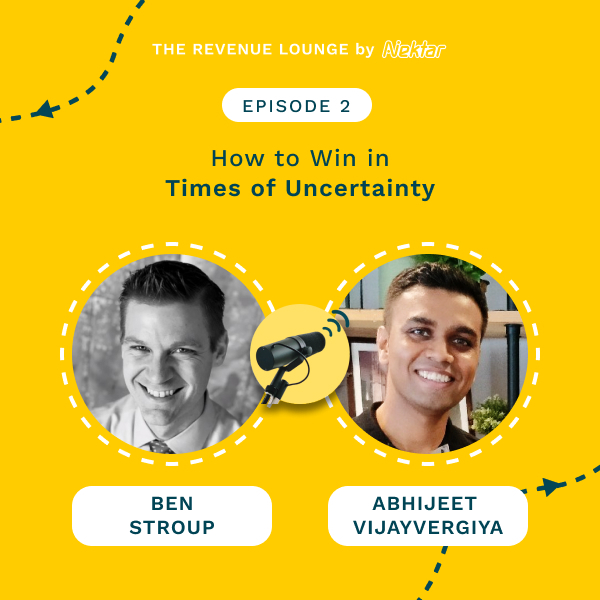
Ep #2: How to Win in Times of Uncertainty
Listen Now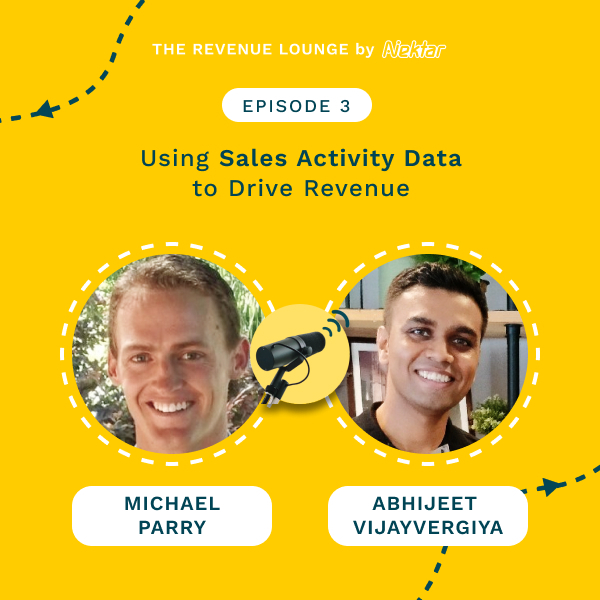
Ep #3: Using Activity Data to Drive Sales Productivity
Listen Now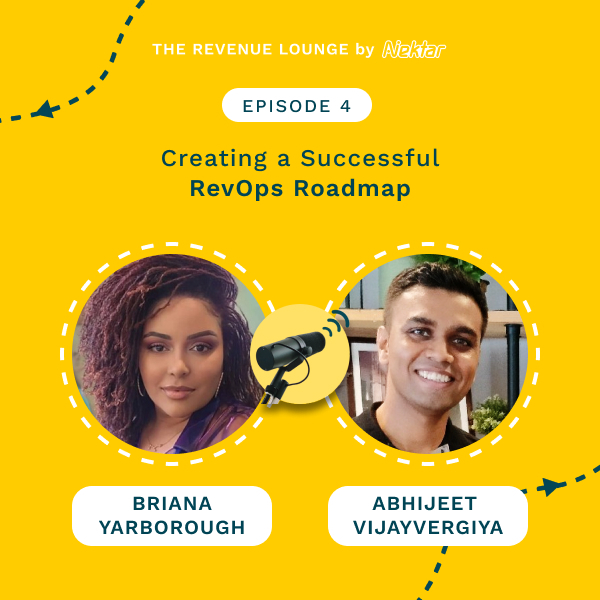
Ep #4: Creating a Successful RevOps Roadmap
Listen Now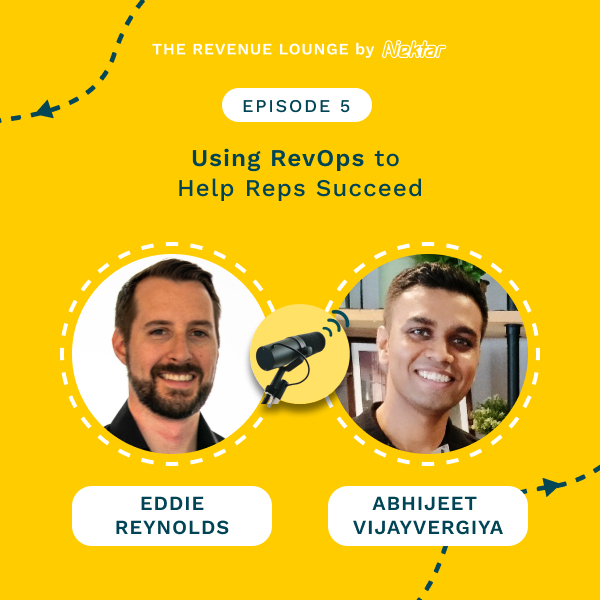
Ep #5: Using RevOps to Help Reps Succeed
Listen Now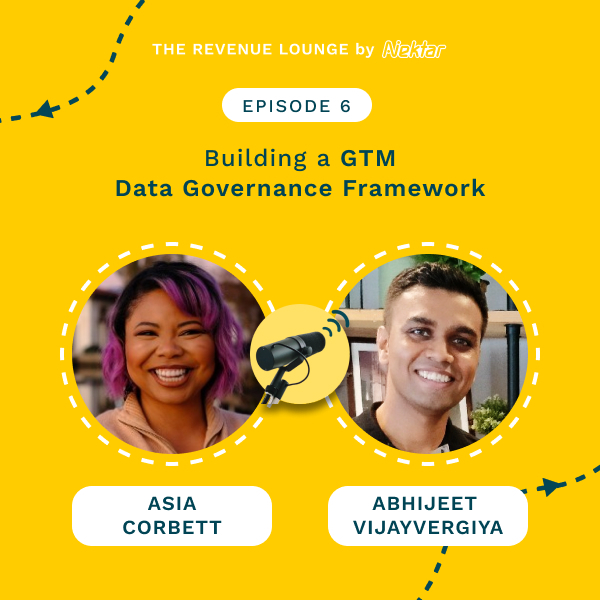
Ep #6: Building a GTM Data Governance Framework
Listen Now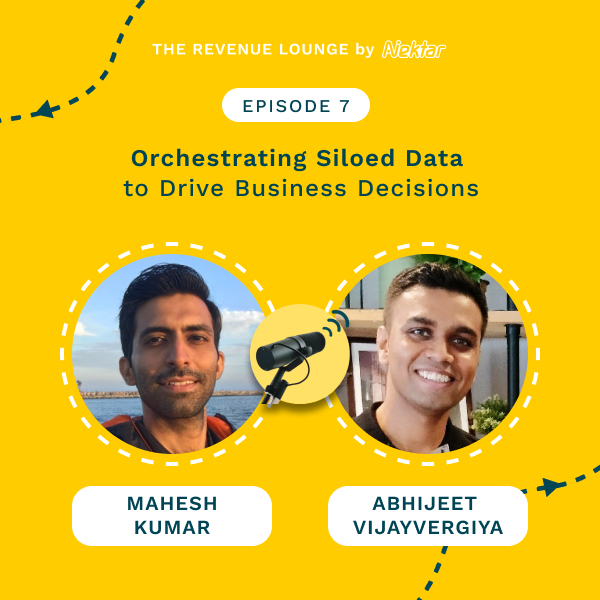
Ep #7: Orchestrating Siloed Data to Drive Business Decisions
Listen Now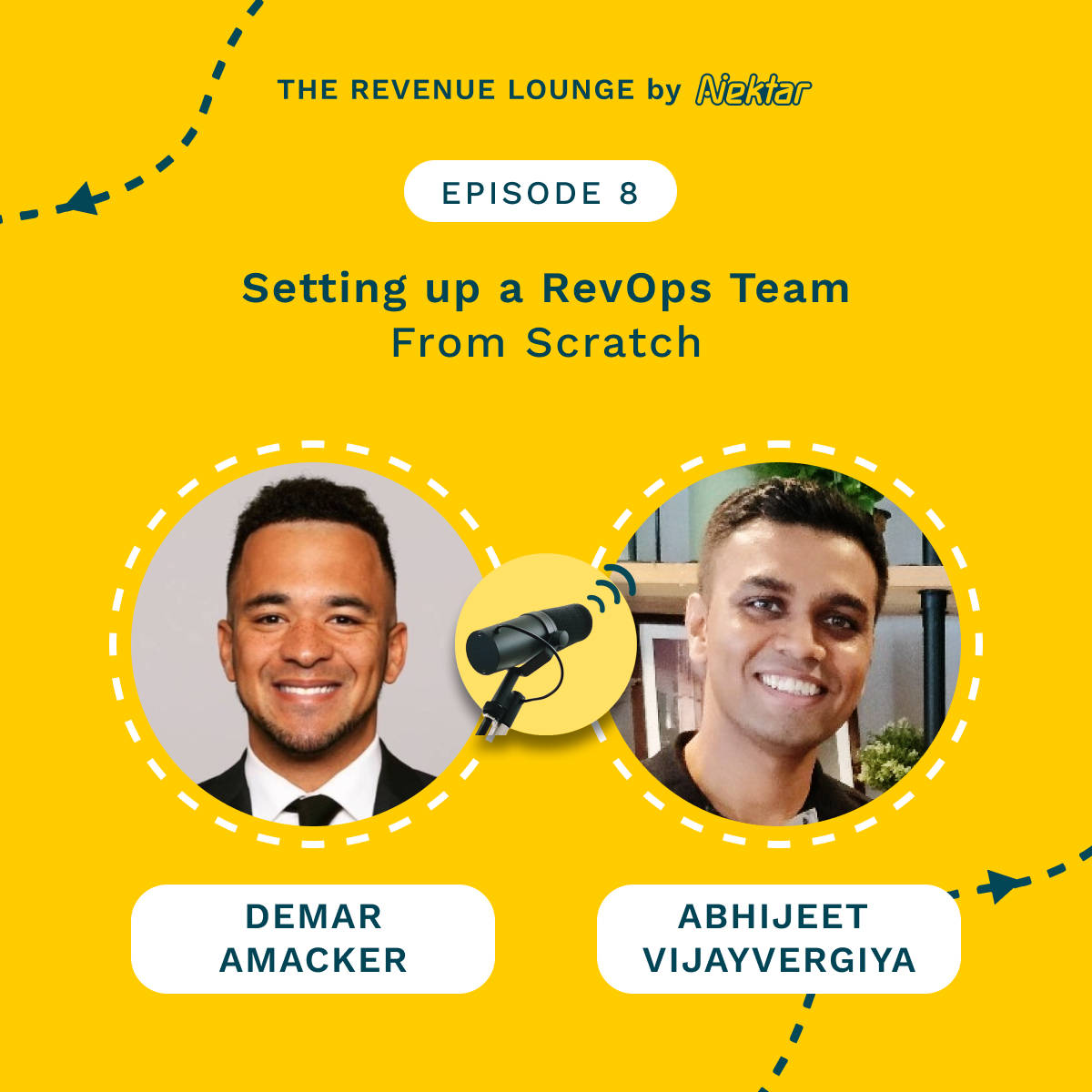
Ep #8: Setting Up a RevOps Team From Scratch
Listen Now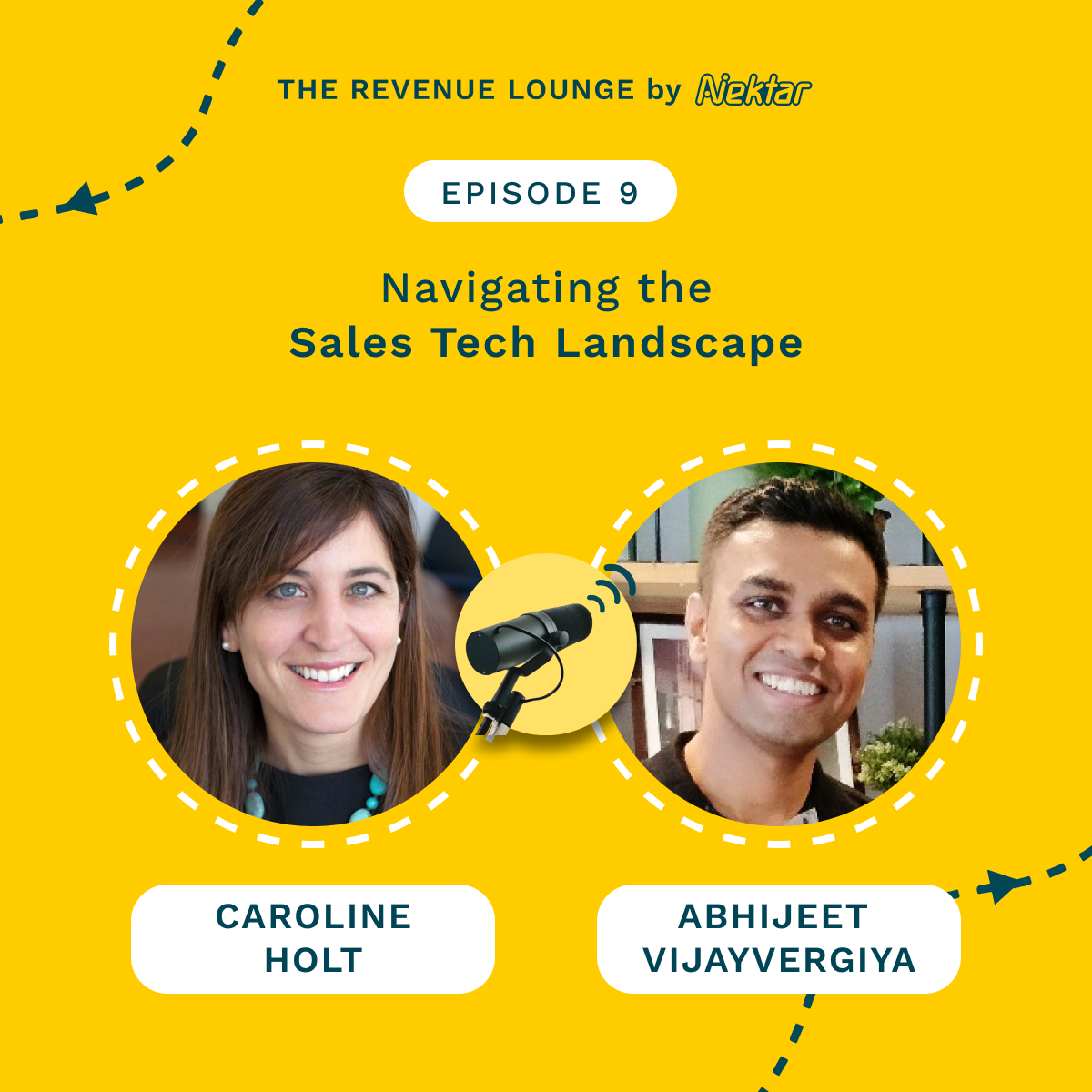
Ep #9: Navigating the Sales Tech Landscape
Listen Now